Abstract
In a study at a primary care centre in a predominantly rural area of Sweden the records of all patients with established thyroid disease were scrutinised and 2000 consecutive adult patients screened with an immunoenzymometric thyroid stimulating hormone assay. The aims of the study were fourfold: firstly, to assess the total burden of thyroid disease in primary care centres in Sweden; secondly, to assess the efficacy of clinical diagnosis of the disease in unselected populations of patients; thirdly, to assess the efficacy of clinical evaluation of treatment with thyroxine; and, lastly, to see whether a single analysis of the serum thyroid stimulating hormone concentration by recent methods would be enough to identify an abnormality of thyroid function. Of the roughly 17,400 adults in the study community, 111 women and 10 men were being treated for thyroid disease. Screening detected 68 patients (3.5%) not receiving thyroxine who had a serum thyroid stimulating hormone concentration of 0.20 mU/l or less, all of whom were followed up clinically. Fifty of these patients were also studied biochemically during follow up. Only nine of the 68 patients had thyroid disease (three with thyrotoxicosis requiring treatment), no evidence of the disease being found in the remainder. Sixteen patients had spontaneous hypothyroidism requiring treatment, and neither these nor three patients with thyrotoxicosis had been detected at the preceding clinical examination. Of 35 patients in whom thyroid disease was suspected clinically at screening, none had laboratory evidence of thyroid dysfunction. In this series 1.3% of all women in the study community (2.6% of all 50-59 year olds) and 0.1% of the men were being treated for thyroid disease at the primary care centre, roughly 1.0% of adults subjected to screening were found to have thyroid disease requiring treatment, and most patients with a thyroid stimulating hormone concentration of 0.20 mU/l or less did not have thyroid dysfunction. It is concluded that measuring the basal serum thyroid stimulating hormone concentration by present methods is insufficient for the biochemical assessment of thyroid dysfunction in unselected populations.
Full text
PDF
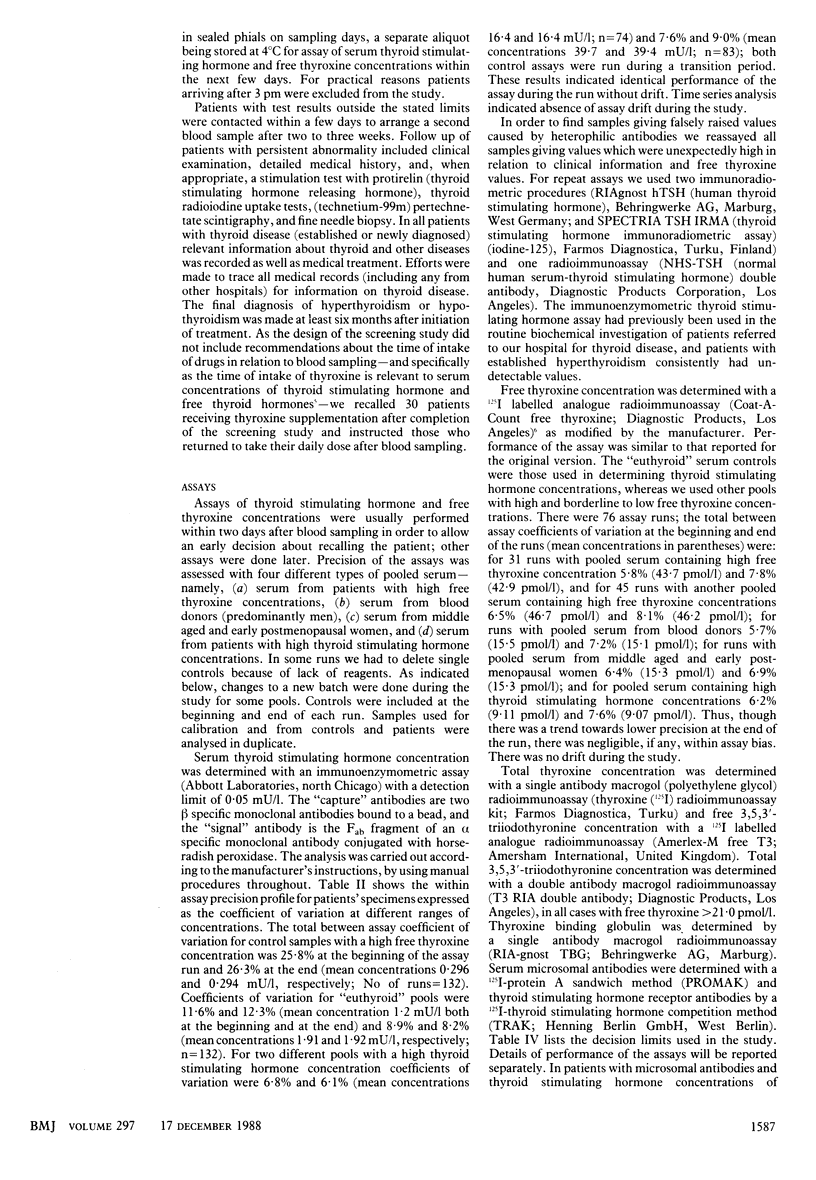
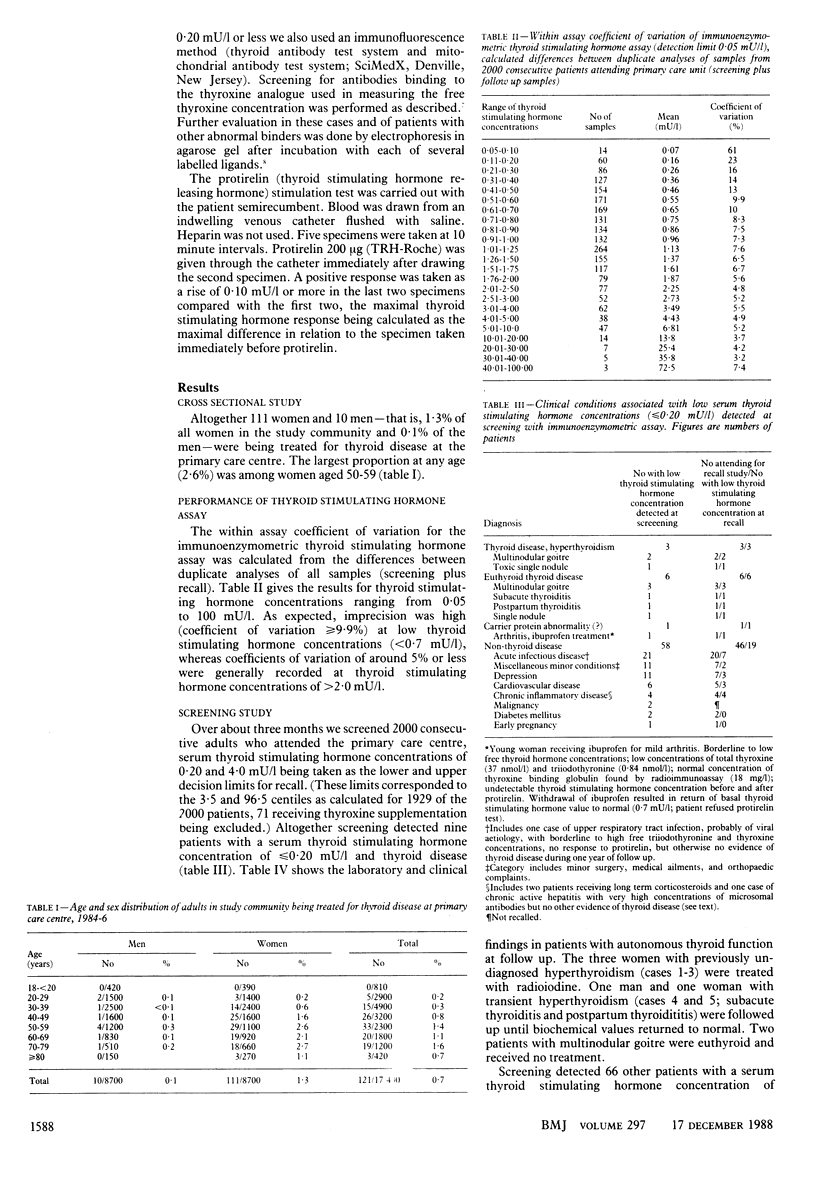
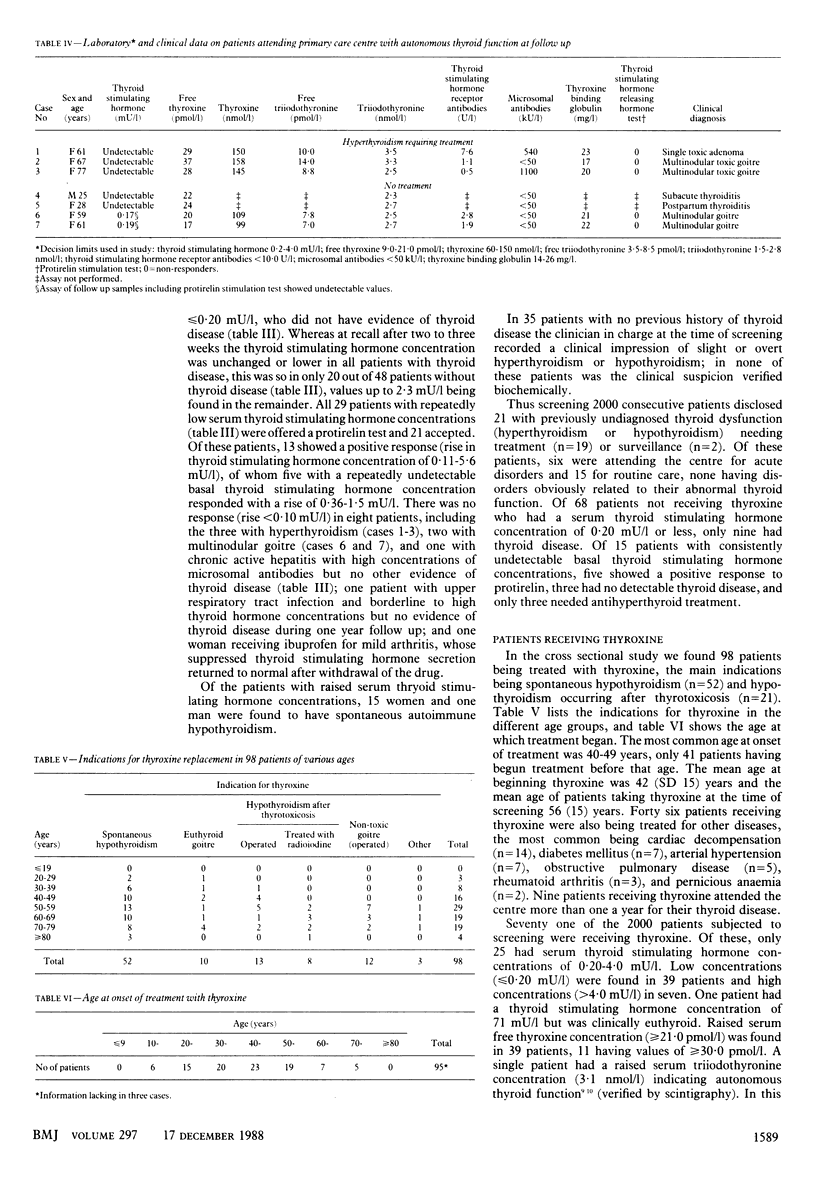
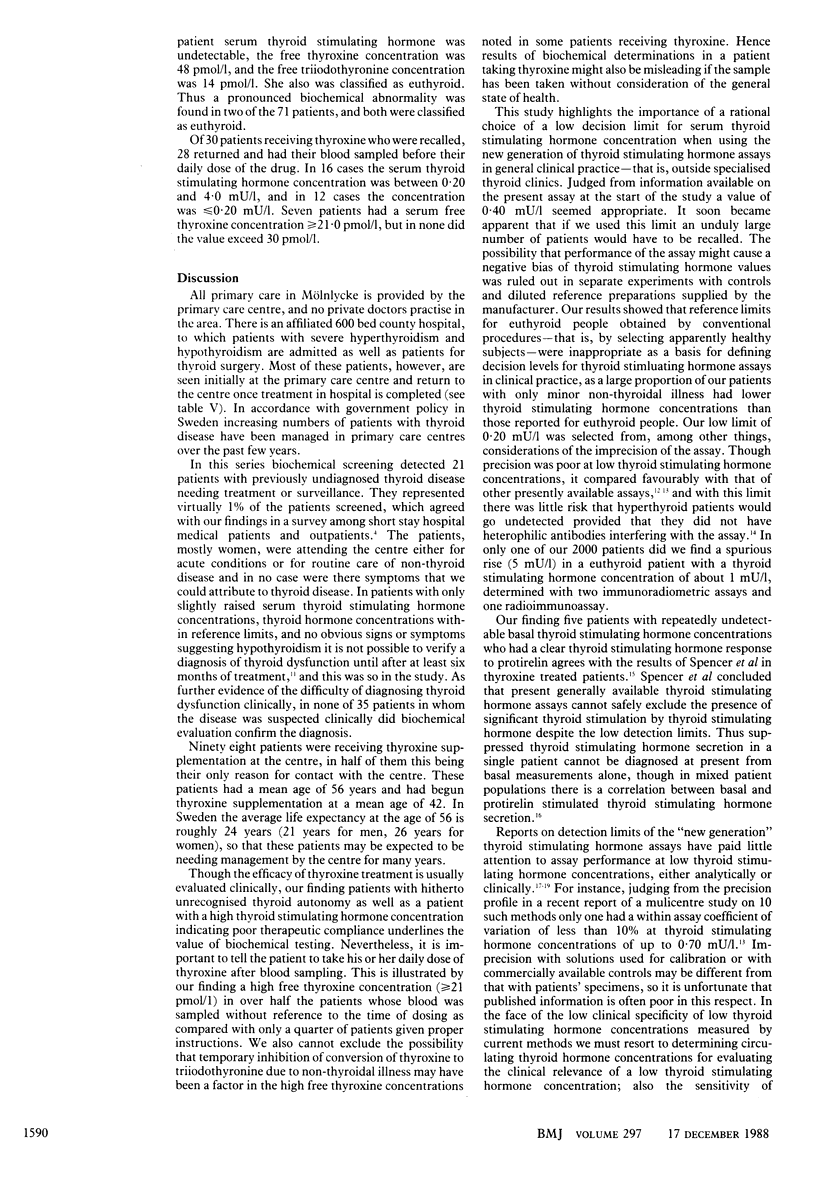
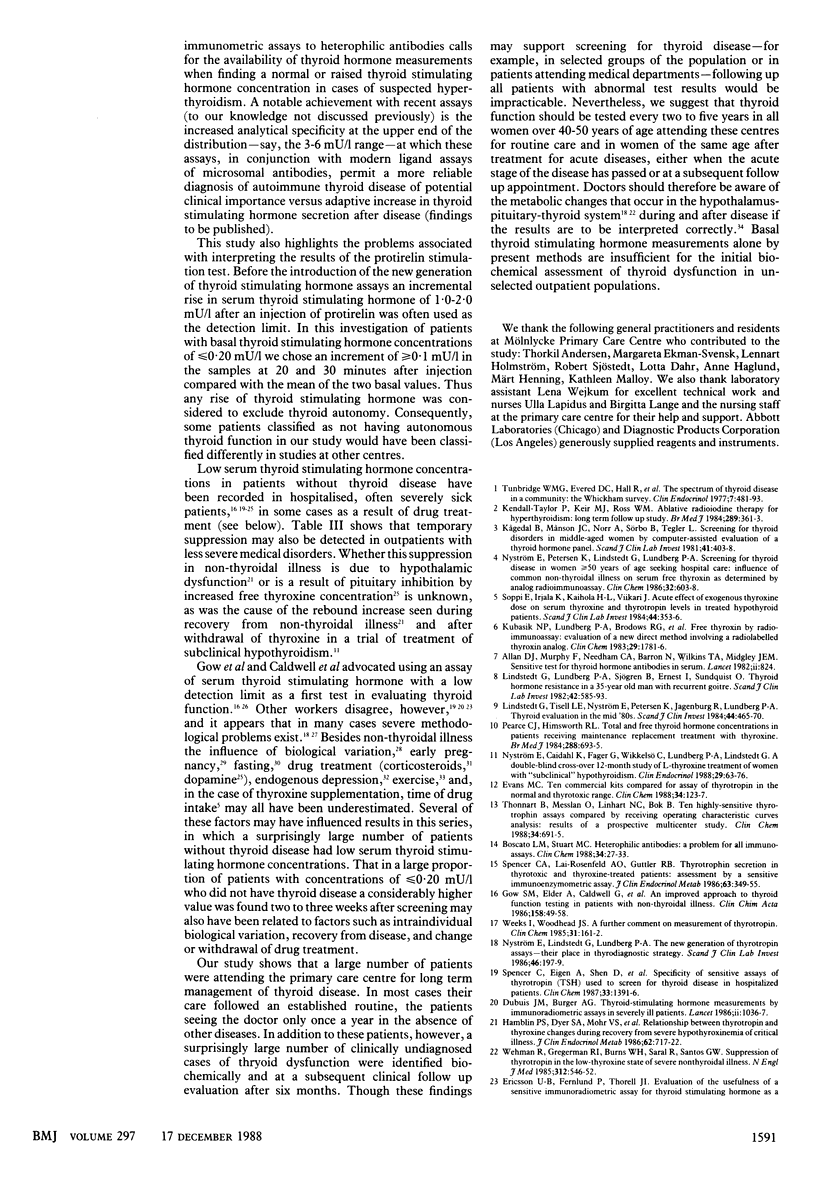
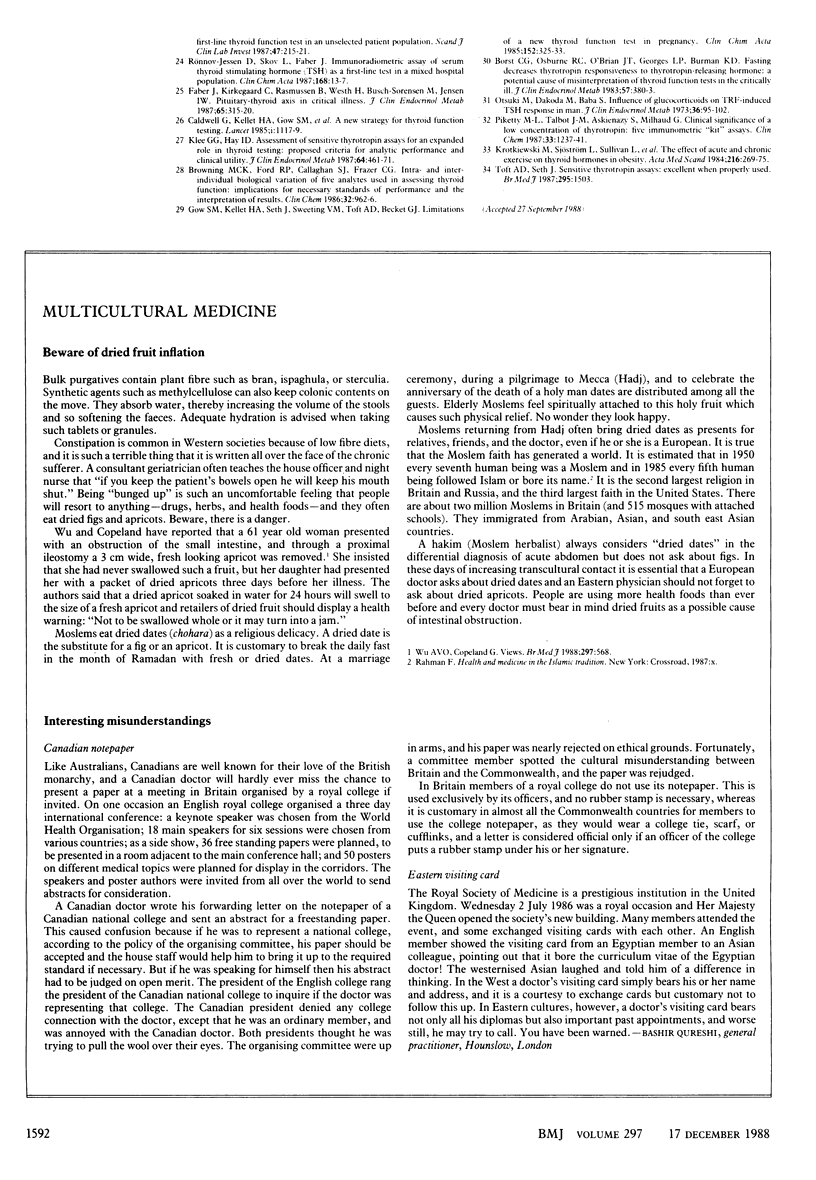
Selected References
These references are in PubMed. This may not be the complete list of references from this article.
- Allan D. J., Murphy F., Needham C. A., Barron N., Wilkins T. A., Midgley J. E. Sensitive test for thyroid hormone autoantibodies in serum. Lancet. 1982 Oct 9;2(8302):824–824. doi: 10.1016/s0140-6736(82)92716-7. [DOI] [PubMed] [Google Scholar]
- Borst G. C., Osburne R. C., O'Brian J. T., Georges L. P., Burman K. D. Fasting decreases thyrotropin responsiveness to thyrotropin-releasing hormone: a potential cause of misinterpretation of thyroid function tests in the critically ill. J Clin Endocrinol Metab. 1983 Aug;57(2):380–383. doi: 10.1210/jcem-57-2-380. [DOI] [PubMed] [Google Scholar]
- Boscato L. M., Stuart M. C. Heterophilic antibodies: a problem for all immunoassays. Clin Chem. 1988 Jan;34(1):27–33. [PubMed] [Google Scholar]
- Browning M. C., Ford R. P., Callaghan S. J., Fraser C. G. Intra- and interindividual biological variation of five analytes used in assessing thyroid function: implications for necessary standards of performance and the interpretation of results. Clin Chem. 1986 Jun;32(6):962–966. [PubMed] [Google Scholar]
- Dubuis J. M., Burger A. G. Thyroid-stimulating hormone measurements by immunoradiometric assay in severely ill patients. Lancet. 1986 Nov 1;2(8514):1036–1037. doi: 10.1016/s0140-6736(86)92641-3. [DOI] [PubMed] [Google Scholar]
- Evans M. C. Ten commercial kits compared for assay of thyrotropin in the normal and thyrotoxic range. Clin Chem. 1988 Jan;34(1):123–127. [PubMed] [Google Scholar]
- Gow S. M., Elder A., Caldwell G., Bell G., Seth J., Sweeting V. M., Toft A. D., Beckett G. J. An improved approach to thyroid function testing in patients with non-thyroidal illness. Clin Chim Acta. 1986 Jul 15;158(1):49–58. doi: 10.1016/0009-8981(86)90115-4. [DOI] [PubMed] [Google Scholar]
- Gow S. M., Kellett H. A., Seth J., Sweeting V. M., Toft A. D., Beckett G. J. Limitations of new thyroid function tests in pregnancy. Clin Chim Acta. 1985 Nov 15;152(3):325–333. doi: 10.1016/0009-8981(85)90108-1. [DOI] [PubMed] [Google Scholar]
- Hamblin P. S., Dyer S. A., Mohr V. S., Le Grand B. A., Lim C. F., Tuxen D. V., Topliss D. J., Stockigt J. R. Relationship between thyrotropin and thyroxine changes during recovery from severe hypothyroxinemia of critical illness. J Clin Endocrinol Metab. 1986 Apr;62(4):717–722. doi: 10.1210/jcem-62-4-717. [DOI] [PubMed] [Google Scholar]
- Kendall-Taylor P., Keir M. J., Ross W. M. Ablative radioiodine therapy for hyperthyroidism: long term follow up study. Br Med J (Clin Res Ed) 1984 Aug 11;289(6441):361–363. doi: 10.1136/bmj.289.6441.361. [DOI] [PMC free article] [PubMed] [Google Scholar]
- Klee G. G., Hay I. D. Assessment of sensitive thyrotropin assays for an expanded role in thyroid function testing: proposed criteria for analytic performance and clinical utility. J Clin Endocrinol Metab. 1987 Mar;64(3):461–471. doi: 10.1210/jcem-64-3-461. [DOI] [PubMed] [Google Scholar]
- Krotkiewski M., Sjöström L., Sullivan L., Lundberg P. A., Lindstedt G., Wetterqvist H., Björntorp P. The effect of acute and chronic exercise on thyroid hormones in obesity. Acta Med Scand. 1984;216(3):269–275. doi: 10.1111/j.0954-6820.1984.tb03804.x. [DOI] [PubMed] [Google Scholar]
- Kubasik N. P., Lundberg P. A., Brodows R. G., Hallauer G. D., Same D. G., Lindstedt G., Bengtsson C., Nyström E. Free thyroxin by radioimmunoassay: evaluation of a new direct method involving a radiolabeled thyroxin analog. Clin Chem. 1983 Oct;29(10):1781–1786. [PubMed] [Google Scholar]
- Kågedal B., Månson J. C., Norr A., Sörbo B., Tegler L. Screening for thyroid disorders in middle-aged women by computer-assisted evaluation of a thyroid hormone panel. Scand J Clin Lab Invest. 1981 Jun;41(4):403–408. doi: 10.3109/00365518109092063. [DOI] [PubMed] [Google Scholar]
- Lindsted G., Tisell L. E., Nyström E., Petersen K., Jagenburg R., Lundberg P. A. Thyroid function evaluation in the mid '80s. Scand J Clin Lab Invest. 1984 Sep;44(5):465–470. doi: 10.3109/00365518409083840. [DOI] [PubMed] [Google Scholar]
- Lindstedt G., Lundberg P. A., Sjögren B., Ernest I., Sundquist O. Thyroid hormone resistance in a 35-year old man with recurrent goitre. Scand J Clin Lab Invest. 1982 Nov;42(7):585–593. [PubMed] [Google Scholar]
- Nyström E., Caidahl K., Fager G., Wikkelsö C., Lundberg P. A., Lindstedt G. A double-blind cross-over 12-month study of L-thyroxine treatment of women with 'subclinical' hypothyroidism. Clin Endocrinol (Oxf) 1988 Jul;29(1):63–75. doi: 10.1111/j.1365-2265.1988.tb00250.x. [DOI] [PubMed] [Google Scholar]
- Nyström E., Lindstedt G., Lundberg P. A. The new generation of thyrotropin assays--their place in thyrodiagnostic strategy? Scand J Clin Lab Invest. 1986 Apr;46(2):197–199. doi: 10.3109/00365518609083659. [DOI] [PubMed] [Google Scholar]
- Nyström E., Petersen K., Lindstedt G., Lundberg P. A. Screening for thyroid disease in women greater than or equal to 50 years of age seeking hospital care: influence of common nonthyroidal illness on serum free thyroxin as determined by analog radioimmunoassay. Clin Chem. 1986 Apr;32(4):603–608. [PubMed] [Google Scholar]
- Pearce C. J., Himsworth R. L. Total and free thyroid hormone concentrations in patients receiving maintenance replacement treatment with thyroxine. Br Med J (Clin Res Ed) 1984 Mar 3;288(6418):693–695. doi: 10.1136/bmj.288.6418.693. [DOI] [PMC free article] [PubMed] [Google Scholar]
- Piketty M. L., Talbot J. N., Askienazy S., Milhaud G. Clinical significance of a low concentration of thyrotropin: five immunometric "kit" assays compared. Clin Chem. 1987 Jul;33(7):1237–1241. [PubMed] [Google Scholar]
- Soppi E., Irjala K., Kaihola H. L., Viikari J. Acute effect of exogenous thyroxine dose on serum thyroxine and thyrotrophin levels in treated hypothyroid patients. Scand J Clin Lab Invest. 1984 Jun;44(4):353–356. doi: 10.3109/00365518409083819. [DOI] [PubMed] [Google Scholar]
- Spencer C. A., Lai-Rosenfeld A. O., Guttler R. B., LoPresti J., Marcus A. O., Nimalasuriya A., Eigen A., Doss R. C., Green B. J., Nicoloff J. T. Thyrotropin secretion in thyrotoxic and thyroxine-treated patients: assessment by a sensitive immunoenzymometric assay. J Clin Endocrinol Metab. 1986 Aug;63(2):349–355. doi: 10.1210/jcem-63-2-349. [DOI] [PubMed] [Google Scholar]
- Spencer C., Eigen A., Shen D., Duda M., Qualls S., Weiss S., Nicoloff J. Specificity of sensitive assays of thyrotropin (TSH) used to screen for thyroid disease in hospitalized patients. Clin Chem. 1987 Aug;33(8):1391–1396. [PubMed] [Google Scholar]
- Thonnart B., Messian O., Linhart N. C., Bok B. Ten highly sensitive thyrotropin assays compared by receiver-operating characteristic curves analysis: results of a prospective multicenter study. Clin Chem. 1988 Apr;34(4):691–695. [PubMed] [Google Scholar]
- Tunbridge W. M., Evered D. C., Hall R., Appleton D., Brewis M., Clark F., Evans J. G., Young E., Bird T., Smith P. A. The spectrum of thyroid disease in a community: the Whickham survey. Clin Endocrinol (Oxf) 1977 Dec;7(6):481–493. doi: 10.1111/j.1365-2265.1977.tb01340.x. [DOI] [PubMed] [Google Scholar]
- Weeks I., Woodhead J. S. A further comment on measurement of thyrotropin. Clin Chem. 1985 Jan;31(1):161–162. [PubMed] [Google Scholar]
- Wehmann R. E., Gregerman R. I., Burns W. H., Saral R., Santos G. W. Suppression of thyrotropin in the low-thyroxine state of severe nonthyroidal illness. N Engl J Med. 1985 Feb 28;312(9):546–552. doi: 10.1056/NEJM198502283120904. [DOI] [PubMed] [Google Scholar]


